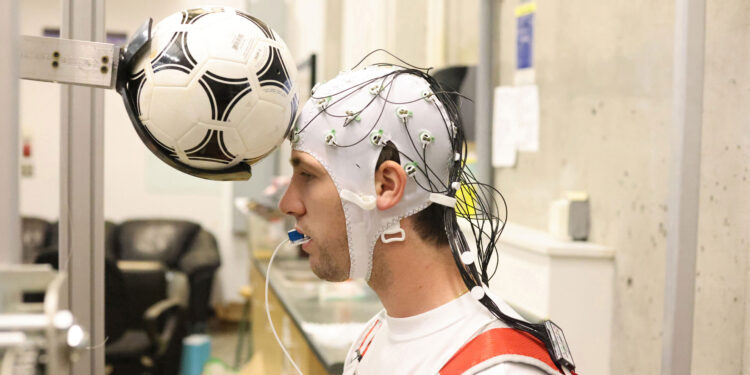The study found that participants experienced brief but statistically significant increases in delta brain waves in the moments following the impact. Credit: UBC Applied Science
Using your head to pass, shoot or clear the ball is common practice in soccer and does not typically lead to concussions. However, a new study from the University of British Columbia finds that even a minor headbutt has measurable effects on the brain.
The study published in the Annals of Biomedical Engineering found that head-butt impacts are followed by a momentary slowdown in brain activity, producing brain waves more commonly associated with sleep and drowsiness.
In the experiment, eight healthy adults performed controlled headers with a soccer ball, using forces comparable to those typically seen during play. They wore electroencephalography (EEG) sensors and custom mouthguards that simultaneously tracked brain activity and head movements.
Participants experienced brief but statistically significant increases in delta brain waves in the moments after the impact, said lead researcher Dr. Lyndia Wu, an assistant professor of mechanical engineering in the School of Applied Science who studies sports-related injuries.
“Delta waves are low-frequency waves that are associated with drowsiness and sleep,” says Dr. Wu. “When this sleep-like delta activity occurs during wakefulness, it can disrupt information processing and cause lapses in attention. For athletes, this can mean decreased focus after an impact.”
She highlighted growing concern about the effects on the brain of repeated exposure to this type of mild head impact.
“This study is unique because it allowed us to measure what happens in the brain immediately after a head impact. There is a growing body of research on subconcussive head impacts, but most studies have only been able to measure post-game or post-season effects, which would not allow us to understand the effects of individual impacts and how they may accumulate.”
The study also looked at the influence of severity and direction of impacts on brain activity. Stronger impacts resulted in a greater increase in delta waves, while oblique impacts resulted in greater activity on the opposite side of the head.
Most participants’ brain activity returned to normal quickly, indicating no long-term effects. However, some showed more pronounced changes, suggesting individual differences in brain response.
“Understanding these changes in brain activity helps us assess how the brain responds to impacts and can inform future safety protocols and guidelines for sports,” added Dr. Wu.
These findings highlight the need for personalized safety measures and further research into how individuals respond to impacts, particularly in sports with frequent head impacts such as soccer and football.
“This research helps us better understand how mild head impacts affect brain function. It paves the way for further studies of repeated impacts and highlights the importance of continued research to protect the health of athletes,” said Dr. Wu. “Our future research could look at the effects of more frequent repeated impacts and how rest time between impacts may affect recovery.”
More information:
Ahmad Rezaei et al., Immediate and transient EEG disturbances within seconds following a controlled head impact with a soccer ball, Annals of Biomedical Engineering (2024). DOI: 10.1007/s10439-024-03602-0
Provided by the University of British Columbia
Quote:Footballers’ Heading Briefly Slows Brain Activity, Study Finds (2024, September 24) Retrieved September 24, 2024 from
This document is subject to copyright. Apart from any fair dealing for the purpose of private study or research, no part may be reproduced without written permission. The content is provided for informational purposes only.



